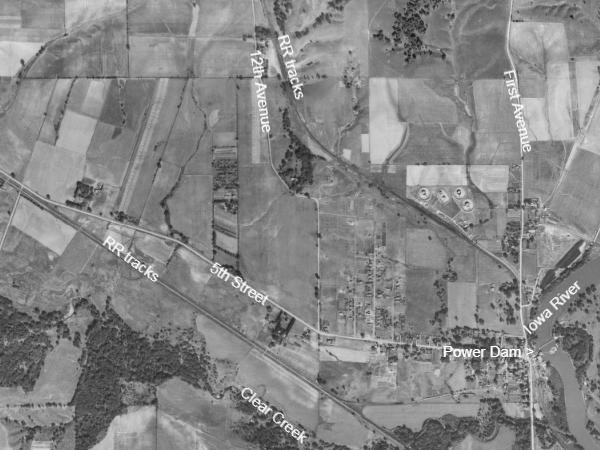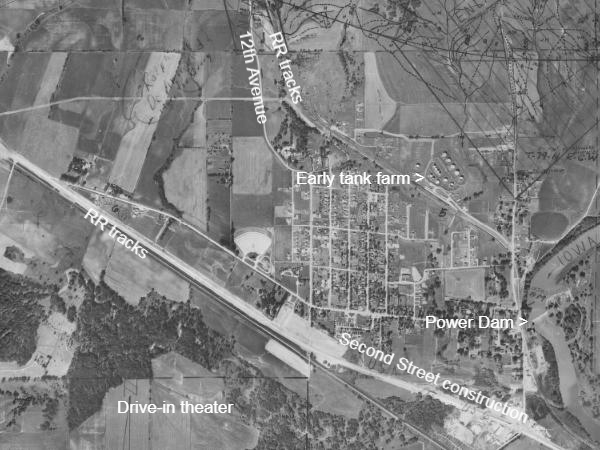The Vultures of Coralville
Last summer, like many summers before it, a flock of turkey vultures was often to be seen over west Coralville. They are very noticeable when circling low, but sometimes I would just stand in Morrison Park looking up and they would be dark specks high above. Other people would see me looking up and our conversation would turn to speculation about why these birds so regularly favor west Coralville with their presence, and what attracts them to migrate here year after year. My spin follows:
Vultures seem to especially like dilapidated old barns for nesting. They favor the haylofts when the upper doors and windows are missing and they can fly directly to the nest unobtrusively. They will also use other abandoned rural structures, which offer overhead shelter, including farmhouses, machine sheds, smokehouses, chicken coops, etc. In the wild they mainly used large hollow trees.
Coralville has its origins as a mill town along the river (see Coralville Named for its Fossils). When the automobile provided easy access, it then became a bedroom community for Iowa City. The 1937 aerial photograph shows the village confined to the east of 12th Avenue.

Air photo 1937. Interstate 80 was built later across the north edge of the area shown. Second Street, the main Coralville Strip today, 5 lanes wide beside the railroad tracks, also did not exist in 1937. (Film was not very sensitive then, requiring long enough exposures that it also captured a bit of the aircraft’s motion, so most air photos from that era are sorta gray and fuzzy.)
So my hypothesis is that as Coralville grew west of 12th Avenue, houses, stores, motels, gas stations, etc., replaced the old farm buildings and hollow trees that had provided vulture nesting, and they adapted by nesting on flat rooftops. An air photo from the 1950s shows suburbia spreading west of 12th Avenue:

Note the drive-in theater west of the new suburbs. Second Avenue is now being built and the swath of bare dirt shows bright against the green vegetation. The tank farm is getting established in the northeast sector. (These photos used to be available in the UI Library and some klutz has drawn a grid of lines in the northeast sector of the image.)
To view more recent air photos of evolving Coralville, go to https://ortho.gis.iastate.edu/. The location is Township 79 North, Range 6 West, Sections 5 and 6.
Vultures have a very sensitive sense of smell, fine-tuned to ripe meat. Experiments have shown that a dead deer in the woods, completely covered with leaves, is easily located by vultures.
There is a family of chemicals called mercaptans, which to you and me smell like skunk, mink, dead mouse, or other similarly rank and unpleasant organic odors. The dead mouse version is deliberately added to natural gas and propane to give them a distinctive odor so that we will notice leaks. Pipeline companies searching for gas leaks watch for vultures circling, knowing that to them it smells like dinner.
In transferring liquid propane from the Coralville tank farm to the trucks that deliver it to rural customers, a small amount always vaporizes and escapes, and may perk vultures’ interest – perhaps the same way you and I react downwind of a donut shop.
Finally, it is well established that many bird species return to nest to the same neighborhood, sometimes to the same backyard, where they were hatched.
So putting all this together suggests to me that succeeding generations of vultures have been returning to Coralville since the west side was rural, perhaps aided by imprinting on one of their favorite odors, too subtle for us to notice. And do notice that this story is an interpretation, with room for other unidentified factors that may also be important. Do you have an alternative version?
Vultures are valuable critters who perform serious sanitation and recycling in our ecosystems. Stay tuned next week and we’ll consider their needs and how to accommodate them in the modern world.


